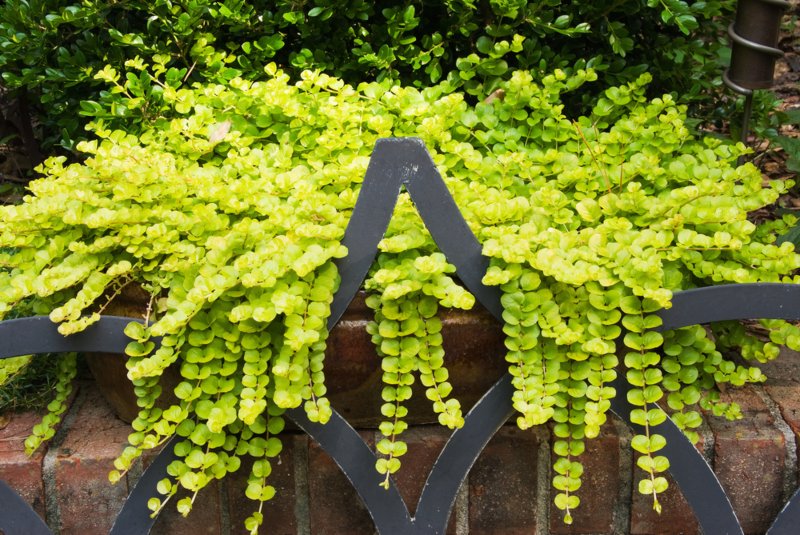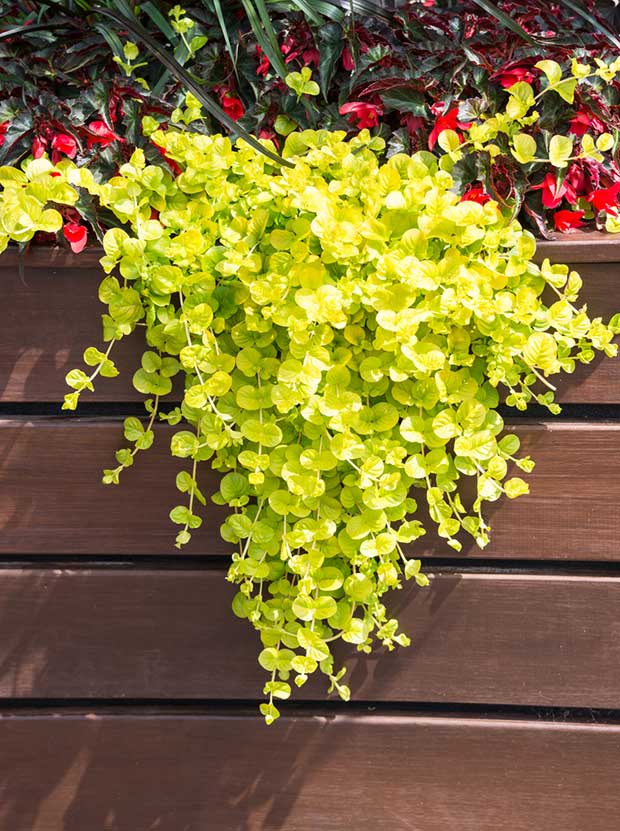
Creeping Jenny (Lysimachia Nummularia) is a member of the primrose family that makes for excellent groundcover or a stunning hanging vine.
Though some consider Creeping Jenny an invasive species, the bright yellow blooms and coin-shaped leaves are gorgeous in a container garden. Planting it in the ground leads to quick coverage, but be warned — Creeping Jenny, or Moneywort, is known for taking over entire areas.
That leads many gardeners and landscapers to seek out the Golden or Auria varieties of Creeping Jenny, which spreads less quickly and may be easier to source in certain locales.
Regardless of the variety, Creeping Jenny does well near ponds and riverbeds. It also looks gorgeous in hanging pots, where its glossy, green leaves will drip over the top, creating a curtain effect.
| Botanical Name: | Lysimachia Nummularia |
| Common Name(s): | Creeping Jenny, Moneywort, Herb Twopence, Twopenny Grass |
| Plant Type: | Perennial |
| Mature Size: | 2-4 inches tall, 12-24 inch spread |
| Sun Exposure: | Full sun to partial shade |
| Water Needs: | Average |
| Soil Type: | Moist, well-draining sand or clay |
| Soil pH: | 6-7.8 |
| Bloom Time: | Summer |
| Maintenance: | Low |
| Flower Color: | Yellow |
| Hardiness Zones: | 4-9 (USDA) |
| Toxicity: | Non-toxic for humans and pets |
Creeping Jenny Care
Creeping Jenny is a low-maintenance plant. It’s fast-growing and will cover bare areas of ground fast. However, it also tends to beat out other plants in its vicinity, making it a semi-invasive species. So, many choose to plant Creeping Jenny in a container of some sort.
Even when you plant it in a confined space, Creeping Jenny tends to appear in other areas of the garden. Dropped cuttings can easily propagate themselves, which is why many people choose to keep their Creeping Jenny in hanging pots, far away from the rest of their garden’s soil.
Keeping Creeping Jenny in drier areas, away from stream-beds or ponds, can inhibit its growth a bit. Seeking out slower-growing varieties like Golden Creeping Jenny can also help keep this plant in check.
Light
Creeping Jenny prefers full sun, but it will grow in the shade as well. When you place it in an area that receives full sun, the leaves will turn more golden-yellow. In shady spots, the leaves turn a dark, emerald green.
Be careful of too much sun in hotter climates as direct sun and heat will lead to blanched leaves.

Water
Creeping Jenny has average water needs. It likes the soil to be moist at all times but doesn’t need excessive watering. If you have it in a pot, try not to let the soil dry out. If you’re growing it as ground cover, consider placing it in a low-lying area or near a water source, like a pond or stream.
Temperature/Humidity
Creeping Jenny does best in moderate climates. It can’t handle too much direct heat and prefers a moist area.
In USDA zones 8 and 9, Creeping Jenny will continue to grow throughout the winter. However, in colder areas, it will disappear completely, only to return each spring.
Soil
When it comes to soil, Creeping Jenny prefers well-draining, sandy areas. Clay-heavy soil works well too.
Though it can grow in acidic, alkaline, or neutral soils, Creeping Jenny prefers a soil pH of 6-7.8.
Fertilizer
For many, the problem with Creeping Jenny is that it grows too much! However, you may still want to provide fertilizer for healthy growth from season to season.
It’s best practice to fertilize Creeping Jenny with a 10-10-10 solution in the early spring. You may also choose to add fertilizer when you’re first planting Creeping Jenny in a new place. Using mulch may also be a good idea if you have issues with water retention.
Toxicity
Creeping Jenny is non-toxic for both humans and pets, making it an ideal plant for many gardens.
Propagation
Creeping Jenny is easy to propagate. You can sow seeds in early spring or use cuttings to grow a new plant.
Using cuttings is the easiest method to Grow Creeping Jenny quickly. Simply cut a few stems just below the first leaf nodes or buds. Then, place the cuttings in a pot filled with well-draining soil (a sand and perlite mixture works best).
Place the pot of cuttings in an area with indirect light for a few weeks. Once you see new leaves growing, the plant is ready for transplanting either to a larger container or to an area of your garden.
Pruning
Pruning is essential to keep Creeping Jenny in check. Prune trailing stems and consider pinching off flowers as they fade to discourage seeding.
In colder climates, you should also cut back any dead stems in fall before winter hits. That will ensure your Creeping Jenny comes back thriving in the warmer seasons.
Tips
Creeping Jenny is prone to fungal diseases that may appear as leaf spots. If you notice any on your plants, consider treating them with a liquid copper fungicide.




